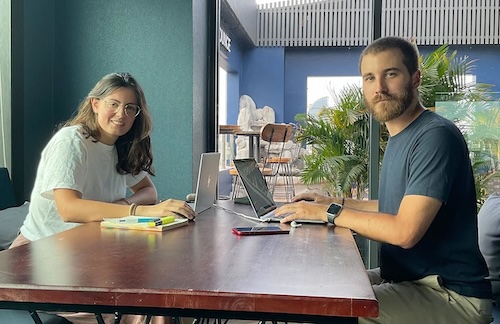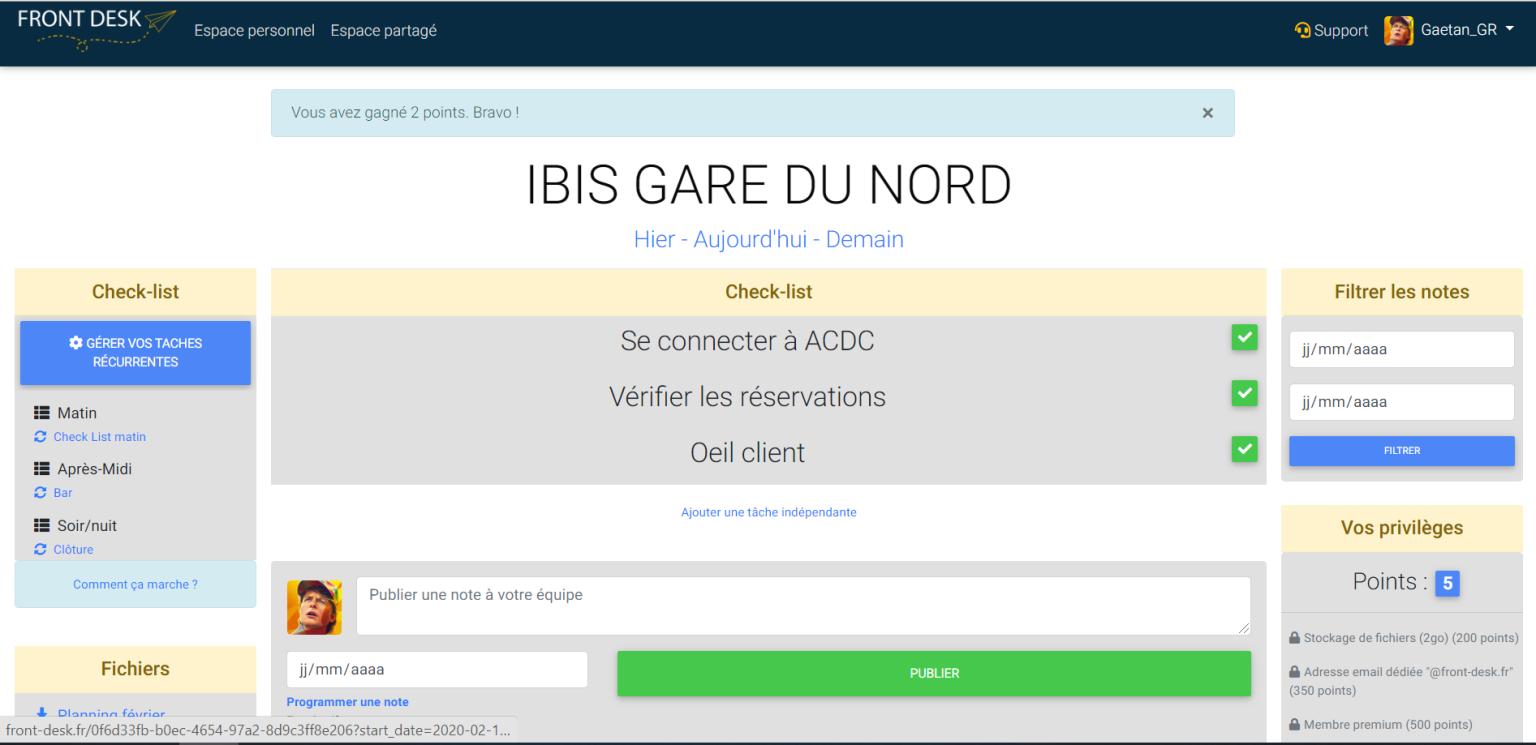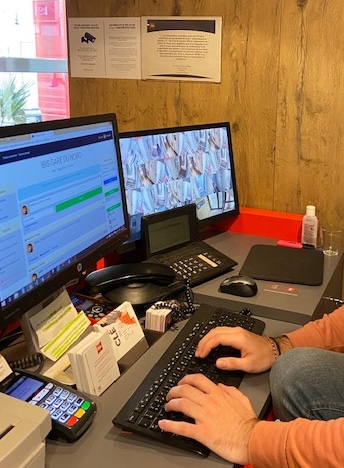Two years ago, on the 15th of January 2022, I decided to launch my startup with my co-founder, a SaaS service built for hospitality professionals to help them with their day-to-day tasks that I was building for the past year.
In those two years, I have travelled to 7 different countries, built a website and two mobile apps from scratch and a lot more.. let’s take a look back at what I have learned.
Know your place…
From the get go, I knew that my strength was in the technical side of things, I enjoy building the product, thinking about ways to improve it, make it better and faster, but when it comes to sales and marketing, I am the opposite of a natural, nothing is more frustrating to me than trying to sell my product or building a marketing strategy.
Fortunately, my co-founder agreed to take care of all the business side of things, from the marketing to the sales and the customer support, she also took care of the financial and the creation of the company, which allowed me to focus solely on the product and the infrastructure.
Having two people with different skills really made the journey much smoother, each of us was the expert in his field and neither me or my co-founder had to worry about the other’s work.
I would from time to time help my co-founder on promoting on social network and customer requests since I was the one who knew the product the best and had 7 years of experience in the hospitality industry.
…But don’t be afraid to step out of it
 The Front Desk team
The Front Desk team
We, as developers, are often criticized for not having the social and business skills to interact and sell our product to customers, we often ship the product and pray that it will sell itself, but that is not how it works, entrepeneur need to wear many hats.
It’s interesting as technical founder to understand how the product is sold, what lies behind the marketing strategy and the sales pitch and how your customers are using your product.
While I still very much prefer building the product, I do find enjoyment in handling customer requests and support, doing so allows me to catch many bugs and bad design choices that I would have never noticed otherwise.
Premature optimization is the root of all evil
 The first version of my product, ugly, unoptimized, but used by hundreds of users
The first version of my product, ugly, unoptimized, but used by hundreds of users
The real problem is that programmers have spent far too much time worrying about efficiency in the wrong places and at the wrong times; premature optimization is the root of all evil (or at least most of it) in programming. - Donald Knuth
Warning : Controversial opinion ahead.
Is your product good enough to be used by your customers ? If the answer is yes, then you should not worry about optimizing it at the early stage, just ship it.
This was latter confirmed by experience and the must-read book The Lean Startup by Eric Ries. which I was lucky enough to read before starting my company,
Your product is going to evolve, you are going to add features, remove some of them, change the way the code works, and you might even pivot to a different market.
Sure you could spend weeks writting the perfect code, target 90%+ code coverage, have a CI/CD pipeline etc.. but since you have no user base you are not going to get any feedback and the perfect code and tests you have written for the pasts ? Straight to the trash.
Of course there are some exceptions, for example the security of your product should be a top priority and not underlooked, you should also choose the right framework and stack right from the start, but do not spend weeks on little details and optimizations that are not yet relevant.
Build a product you would use
 Using Front Desk at work
Using Front Desk at work
Like I said earlier, I have spent 7 years of my life working for the hospitality industry, and the product I have built is something I would have loved to use back then.
7 years is a lot of time gathering valuables feedbacks from colleagues and my own use, translating this into my dream tool was easy.
I had the chance to use my product for 5 months in real condition at my previous hotel in Paris, and it was rewarding to see that the product I had built was actually useful and my colleagues were enjoying using it.
This is also the difference between being passionate about a product and being passionate about a technology, fortunately for me it was both, but lacking one of them would have made the journey much harder.
Story time : Before transitioning to a full time entrepreneur, I was working as a full stack developer for an insurtect startup, and while I was enjoying the technical challenges, I could not be passionate about the product we were building, I lasted only 3 months.
What are you trying to solve ?
I am always excited to help other developers and entrepreneurs launch their products and since I am quite active on Linkedin and Discord I had many people reaching out to me for advice.
The first question I always ask is “What are you trying to solve ?”
If you are trying to build another social network, or a new dating app, you are going to have a hard time, because you are not solving a problem, you are just trying to build a better version of an existing product, you are more excited about the technology than the product itself.
For me that was the easiest part, since my colleagues and I were already using the product and I knew from experience that such tool was not only needed but also missing from the market.
As I said earlier, I have no background in business, but doing a small market research and understanding the problem you are trying to solve is the difference between spending 1 year building a product that no one wants or spending 2 days realizing that your idea is not viable.
The only case where it is ok to build a product for the sole purpose of a new technology is when learning or doing it as a side project, at worst no one will use it and you will have learned a new technology, at best a new income stream.
Invest in your infrastructure and save your sanity
 One bad day, could have been avoided with the right infrastructure
One bad day, could have been avoided with the right infrastructure
When I first started my company, I was managing the infrastructure and every aspect of my product myself, the backups, the database, the servers, the CI/CD pipeline, the monitoring, the logs, the security, the list goes on and on, it was overwhelming and honestly very stressful.
One thing I remember telling myself was that the more revenue I would make the more I would invest in services to make my life easier and less stressful.
Managing your own infrastructure is a full time job, and while it is a great learning experience, I would recommend doing that for your own personnals projects or at a very early stage, problems will arise and you don’t want to deal with a missconfigured server when you are pushing a new feature to your customers.
Here is a list of the services I am still using to this day:
Monitoring tool (keep me informed of any downtime and latency, by email and sms) : Better Stack
Logs management (keep track of issues, 5xx errors, database queries) : Sentry
Managed database (no need to worry about backups, replication, scaling) : Digital Ocean Managed Database
Managed servers (for Redis and Postgres) : Digital Ocean App Platform
Automated database Backups (daily backups, replication, easy download and restoration) : Snapshooter
Be friend with Github copilot
A.I is here to stay and while I agree that it can make us lazy, when you are the single dev of your product, it is better to let A.I do the heavy lifting for you.
The best example I can give think of is when I was working on building the mobile app for my product, I had never worked with Flutter and mobile development before. With Flutter everything is a widget, which is basically a class, and you have to build your UI by nesting widgets inside each other, the code can be intimidating but also repetitive.
Github copilot helped me a lot by auto generating the code for me, and while I had to tweak it a bit, it saved me a lot of time and frustration.
Of course I still had to learn Flutter and Dart, but I was not stuck for hours on a single problem, Github Copilot can be a valuable tool as long as you take the time to read the code it generates and try to understand it.
Customer is not always right
Customer feedback is what made my product 100 time better, I have spent countless hours on the Zoom, by email and over the phone with my customers, listening to their feedbacks, frustrations and needs, and I have always tried to implement their suggestions based solely on my own judgement and experience.
But customer are not programmer, they do not understand the technical challenges of building a product, nor do they understand that other customers might have different needs, this is where you should step in and make the right decision.
There is no shame in refusing a feature request, I would even say that it shows a strong vision and maturity from your part, trust me they have thousands of ideas but unfortunately your time is limited.
This is a very hard thing to do and the balance is not easy to find, don’t try to please them all, after all you are the expert, you will thank me latter.
Focus on your core product
 Early stage at Front Desk
Early stage at Front Desk
Following the previous point, you should always focus on your core product, the one that makes you different from your competitors but also the one that your customers are paying for and using the most.
I often made the mistake of trying to implement every single feature my customers were asking for, and while it was sometimes a good idea, it was often a total waste of my time and ressources, leading to technical debt and product bloat.
To this day I am still facing the consequences of wanting to please every requests from my customers, and getting rid of already implemented features is a pain.
Linkedin is a weird place
it’s becoming the only game in town. Facebook has been a wasteland for years. X, as Twitter is now known, is subject to Elon Musk’s mercurial whims. TikTok’s short-form video is a different form of content.
It’s not just you. LinkedIn has gotten really weird. - Business Insider
40% of my paying customers came from Linkedin, so I spent a lot of time building my network, posting content, and interacting with my connections, so was it worth it ? Yes ! Did I enjoy it ? No.
On Linkedin almost everyone is trying to sell you something and since the network rewards engagement, the posts are often clickbaits, weirdly motivational and out of touch with reality, remember the crying ceo ?
Linkedin is also a social network that is tied to your professional life and because of that people usually refrain from posting their real thoughts and opinions, since it could hurt their career, so you are left with a culture of positive thinking and posts that you disagree with but can’t say anything about.
Linkedin slowly became the Facebook it was trying to avoid, and while lot of businesses including mine can benefit from it, I still think that as any social network, you should spend as little time as possible on it and learn to read between the lines.
LinkedIn is becoming a site where regular people actually want to hang out and post their thoughts. It might even be cool, says Rob Price on this article.
Enjoy the journey
 Traveling in Cambodia
Traveling in Cambodia
In 2 years I have travelled to 7 different countries, including Cambodia, Thailand, Vietnam, Indonesia, Malaysia, Laos and Spain, I have also built a product from scratch, learned new technologies and skills, built two mobile apps, and met a lot of interesting people.
Let’s face it, entrepeneurship is hard, you have fewer benefits, no paid vacations, no sick days and less interactions with other people than you would otherwise have in a regular job, but I enjoyed the journey because I tried to make the most of it, still looking back I wish I had taken more time for me during my travels.
I still lack the entrepreneur mindset that most people on social network like to brag about and I am not sure I will ever have it, but building and selling a product is a rewarding experience that I would surely do again, but much better this time.
Final note : You can find all photos from my travels on the photo section of my website : Photos
